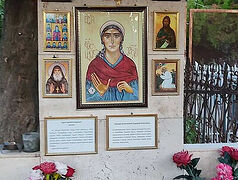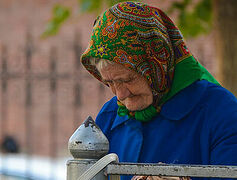The foolishness of God is wiser than men
(1 Corinthians 1:25)
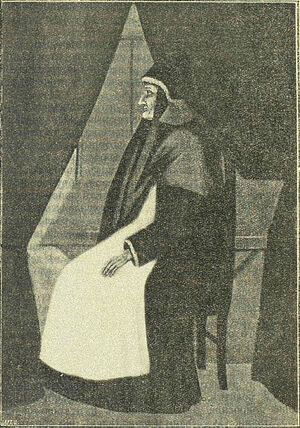 St. Euphrosyne of Kolyupanovo People seeking the salvation of their souls walk towards God in various ways: Laypeople try to live according to God’s commandments, some enter a monastery, and only a few take on the great spiritual feat of feigned foolishness for Christ’s sake—that is, they behave like madmen while being absolutely sane. The names of Russian holy “fools-for-Christ” are widely known—Sts. Basil of Moscow, Xenia of St. Petersburg, Parasceva (“Pasha”) of Sarov, etc. Today we will talk about the amazing life of Blessed Euphrosyne of Kolyupanovo (Aleksin).
St. Euphrosyne of Kolyupanovo People seeking the salvation of their souls walk towards God in various ways: Laypeople try to live according to God’s commandments, some enter a monastery, and only a few take on the great spiritual feat of feigned foolishness for Christ’s sake—that is, they behave like madmen while being absolutely sane. The names of Russian holy “fools-for-Christ” are widely known—Sts. Basil of Moscow, Xenia of St. Petersburg, Parasceva (“Pasha”) of Sarov, etc. Today we will talk about the amazing life of Blessed Euphrosyne of Kolyupanovo (Aleksin).
Mother Euphrosyne (Evdokia in Holy Baptism) was born in about 1758 into the family of Prince Gregory Ivanovich Vyazemsky. In 1764, when she turned six, her parents sent the princess to the newly opened St. Petersburg Smolny Institute of Noble Maidens, a closed privileged educational institution for daughters of the nobility. There pupils were taught arithmetic, history, geography, physics, French, and fine arts. In 1776, the eighteen-year-old Evdokia Vyazemskaya became a lady-in-waiting at the court of Empress Catherine the Great. As Evdokia herself later recalled, her duties included “entertaining the Empress when she felt bored.” While living in high society, she met the commander Alexander Suvorov, Prince Yury Dolgorukov, the future Mayor of Moscow, and made friends with his daughter Barbara.
But the luxury of court life was a burden to her. Since childhood she dreamed of devoting herself to the service of God. Once, when the imperial court was staying in Tsarskoye Selo, she along with two friends (the ladies-in-waiting M. Ya. Sonina and Salome) pretended they had drowned. The maidens left their dresses on the bank of one of the Tsarskoye Selo ponds and fled, dressed as peasants. They left the earthly Empress to serve the Heavenly King. For over a decade Evdokia wandered through various convents, working in their farmyards as an obedience and baking prosphora. This is how she prepared herself for a high feat of prayer.
In 1806 in Moscow she met with Metropolitan Platon (Levshin), who blessed her for the difficult spiritual feat of feigned foolishness. The wise archpastor sent the princess with a letter of recommendation to Vladychny (“of the Sovereign Lady”) Convent of the Entrance of the Mother of God into the Temple in the town of Serpukhov under the false name of “Euphrosyne the fool”. It is likely that then Evdokia was tonsured with the name Euphrosyne. In the letter the metropolitan informed Abbess Dionisia about St. Euphrosyne’s noble origin. The abbess accepted the new sister graciously and placed her in the sisters’ building. However, soon Euphrosyne, seeking solitude, moved to a small hut on the site of the convent’s cellars, where she struggled absolutely alone for almost forty years, subjected to ridicule, insults, deprivation and even beatings from others—which she endured with profound, truly Christian humility.
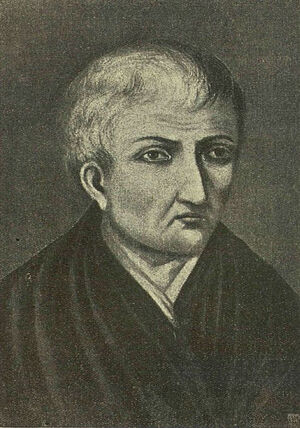 Eldress Euphrosyne St. Euphrosyne prayed unceasingly. She usually prayed in the chapel next to the convent, and came to the convent’s cathedral for church services. She confessed her sins to the convent’s father-confessor and received Communion only once a year on Holy Thursday. At night Euphrosyne wandered around the convent reciting psalms. On the feast of Theophany she went along with the cross procession from the Serpukhov Cathedral to the Nara River and immersed herself in the “Jordan”1 in her clothes, calling to others: “Come on you guys, it’s a hot bath! Go and wash yourselves!” Her clothes immediately froze, and she walked in them barefoot to her squalid cell.
Eldress Euphrosyne St. Euphrosyne prayed unceasingly. She usually prayed in the chapel next to the convent, and came to the convent’s cathedral for church services. She confessed her sins to the convent’s father-confessor and received Communion only once a year on Holy Thursday. At night Euphrosyne wandered around the convent reciting psalms. On the feast of Theophany she went along with the cross procession from the Serpukhov Cathedral to the Nara River and immersed herself in the “Jordan”1 in her clothes, calling to others: “Come on you guys, it’s a hot bath! Go and wash yourselves!” Her clothes immediately froze, and she walked in them barefoot to her squalid cell.
For her humility and unceasing prayer, the Lord bestowed the gift of prophecy upon the eldress. For example, she predicted the French Revolution of 1848, which put an end to the reign of King Louis Philippe, the restoration of the Empire by Napoleon III (1852), the Crimean War (1853–1856) and the defense of Sevastopol (1854–1855). She predicted many events from the personal lives of people who came to her. The blessed eldress, by the grace of God, also possessed the gift of healing. This attracted people to her who needed healing, comfort, or good advice. She cured sick people who turned to her for help with herbs she gathered in the forest.
Strict towards herself, always limiting herself in everything, the blessed eldress never remained indifferent to human grief, suffering and hardships. At the sight of any great adversity that befell people she always hurried to prayerfully help the unfortunate. Once there was a terrible drought in Serpukhov and its surroundings—the grass was burnt, the earth cracked, people were exhausted from the heat, and animals were dying from hunger. On a sultry day, the eldress came to the abbess and said, “Why are you idle? Call the priest right away! Let’s go to the field to pray!” The abbess obeyed, and immediately after the prayer service a heavy rain poured down, watering the ground.
The austere ascetic life of the Blessed Eldress Euphrosyne was well known to the holy Metropolitan Philaret (Drozdov) of Moscow, who, visiting the Serpukhov convent, would have long conversations with St. Euphrosyne. When she received his blessing, she would reverently kiss his hand—and the holy archpastor would in turn kiss the eldress’ hand.
St. Euphrosyne did not go to the sisters’ common meal, but took only some bread and kvass from the convent’s kitchen. Occasionally she drank tea. She slept reclining on the bare floor and only for two hours a day. She would wear a hairshirt made of thick cloth, over which she put on a worn-out housecoat, and in winter—a man’s sheepskin coat. On the Church feasts St. Euphrosyne wore a caftan made of homespun cloth. With her permission, her portrait was painted in such a “costume”. Under her clothes she wore heavy chains—an iron chain with a large copper cross. Her hair was always cut short; sometimes she wrapped a rag around her head or put on a cap. The eldress always went barefoot, even in winter. In summer she stoked the stove, and in winter it was cold in her hut.
A lover of animals, St. Euphrosyne kept two cats, three dogs, chickens, and turkeys in her hut. She slept on the floor with the dogs. When asked why she did that, the eldress replied, “I’m worse than a dog.” She talked to her pets as if they were human beings. A raven would fly to matushka and she would feed it. Once there was a fire in her cell—someone threw a burning bunch of straw through an open window. While putting out the fire, the eldress received severe burns and after that she lay for six weeks without receiving help from anyone. And only her faithful friend, the raven, brought her berries and pieces of bread in its beak. Since the blessed eldress never cleaned her cell, there was always a stench in it. When an abbess from Moscow asked her, “Mother, why do you keep animals? It smells terrible in your hut!” she laughed and replied, “It’s instead of the perfume that I used so much in the royal court.”
One day, when the blessed eldress was sitting on a bench near the convent’s fence, some young hooligans passing by began throwing stones and sticks at her. She got up and walked over to them, saying, “Come on, hit me and spit at me!” They turned away and walked away.
 Blessed Euphrosyne’s hut, built for her by Alexei Tsemsh
Blessed Euphrosyne’s hut, built for her by Alexei Tsemsh
During the Patriotic War of 1812, when Napoleon’s army approached Moscow and French troops stopped near Vladychny Convent, the French officers, seeing a strangely dressed woman, began to mock her. But in response to their insults she threw them completely off by rebuking them in perfect French. Completely staggered by the barrage, they apologized and left.
The enemy of the human race sowed hostility to the blessed eldress in the new abbess’ heart, and in 1845 the saint in her old age had to move from Serpukhov to the village of Kolyupanovo in the Alexin district of Tula province. St. Euphrosyne took with her only an icon of Jesus Christ from Vladychny Convent. The local landowner Natalia Alexeyevna Protopopova came to love the holy eldress, built her a separate hut and planted trees around it. And the blessed eldress drove into it a cow (which people who loved her had given), and she chose for herself a tiny room in an outbuilding, where, as in the convent, she kept animals. Here the saint spent the final ten years of her life, which is why she became known as Euphrosyne of Kolyupanovo (Alexin).
But those who loved St. Euphrosyne visited her even in Kolyupanovo. They flocked from everywhere, asking for her prayerful help, thanking her for healing. Trying to avoid human fame, St. Euphrosyne would go a mile away from Kolyupanovo to a deep ravine on the banks of the Oka River, where she would immerse herself in prayer. A small stream, known as the Proshenka River, flowed at the bottom of the ravine. In the 1840s the ascetic dug a small well there with her own hands. When sick people turned to her for help, she would tell them, “Draw water from my well, and you will be healthy.” In 1848, cholera was raging everywhere, claiming many lives every day; but in the parish of the village of Kolyupanovo, through the prayers of the blessed eldress Euphrosyne, the mortality rate (as evidenced by the registers stored in the church archive) was even lower than in previous and subsequent years.
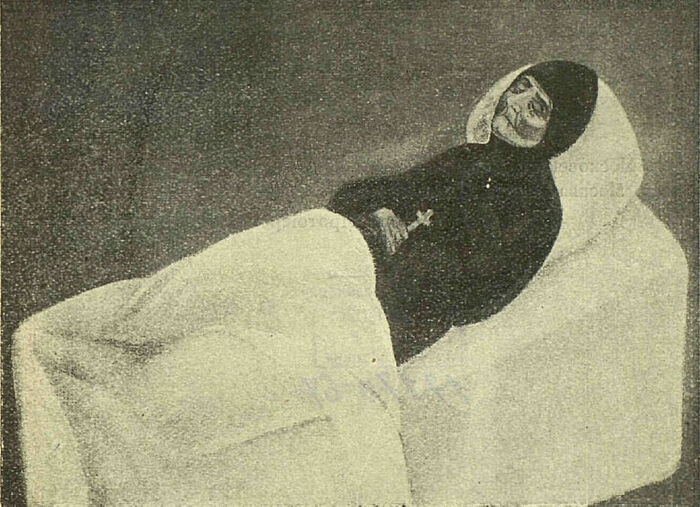 Blessed Euphrosyne on her deathbed
Blessed Euphrosyne on her deathbed
In conversations with her father-confessor, Hieromonk Pavlin (Prosperov), the eldress predicted that in the future a convent would appear in Kolyupanovo, and her words came true in the late twentieth century.
Three weeks before her repose, Blessed Euphrosyne related a vision that she had: “Two angels in white robes came out of the church and called to me: ‘Euphrosynyushka2, it’s time for you to follow us!’” The news that the eldress had predicted her death quickly spread throughout the area, and locals began to come to her to bid their farewells and receive her blessing. She gave crosses, icons, and clothes to many people as keepsakes to remind them of her. On July 3, 1855, the eldress received Communion and fell asleep in the Lord peacefully. Those who were nearby recalled that at that moment the room was filled with fragrance. She was buried in monastic vestments inside a local wooden church. The funeral service was performed by seven priests. A wooden tomb with a cast-iron slab was placed over the grave, on which, with the blessing of St. Philaret of Moscow, was inscribed: “Euphrosyne the unknown. God hath chosen the foolish things of the world to confound the wise (1 Cor. 1:27).” By decree of the Tula Spiritual Consistory of November 7, 1909, a special book was opened at the church, where cases of healing through prayers to St. Euphrosyne of Kolyupanovo were recorded. A year later, fifty-five such testimonies were collected in the book. In 1931, the Church of the Kazan Icon burned down, and the grave and the well were in disrepair.
 St. Euphrosyne of Kolyupanovo, an icon St. Euphrosyne of Kolyupanovo was greatly venerated by Anastasia Ivanovna Tsvetaeva (1894–1993), the sister of the great poet Marina Tsvetaeva (1892–1941). While in exile in Siberia, Anastasia rewrote the ascetic’s Life, painted her portrait and hung it on the wall. One day, after praying to Blessed Euphrosyne, Anastasia Ivanovna was cured of acute tonsillitis. In 1959, Tsvetaeva went to the Tula region and found the spring of the Blessed Eldress Euphrosyne. From that time on, she travelled to this holy well every year until her death in 1993.
St. Euphrosyne of Kolyupanovo, an icon St. Euphrosyne of Kolyupanovo was greatly venerated by Anastasia Ivanovna Tsvetaeva (1894–1993), the sister of the great poet Marina Tsvetaeva (1892–1941). While in exile in Siberia, Anastasia rewrote the ascetic’s Life, painted her portrait and hung it on the wall. One day, after praying to Blessed Euphrosyne, Anastasia Ivanovna was cured of acute tonsillitis. In 1959, Tsvetaeva went to the Tula region and found the spring of the Blessed Eldress Euphrosyne. From that time on, she travelled to this holy well every year until her death in 1993.
The Orthodox ascetic Euphrosyne was canonized in 1988 as a locally venerated saint of the Tula Diocese as “Blessed Euphrosyne”.
In 1996, on the site of the burned-down Church of the Kazan Icon of the Mother of God, a stone Kazan Church was built, in which a marble shrine was placed over the grave of St. Euphrosyne of Kolyupanovo with an icon of the Blessed Eldress Euphrosyne above it. Numerous healings occur from the relics and at the spring dug by the ascetic. On July 16, 1995, as St. Euphrosyne had predicted, the Convent of the Kazan Icon of the Mother of God was established at the Church of the Kazan Icon.
Twice a year on the saint’s feast-days—July 16 and October 8—at the Convent of the Kazan Icon in the village of Kolyupanovo services are celebrated, prayers with the akathist to the saint are read on her grave, and cross processions to the holy spring are held, attracting many pilgrims.
Holy Mother Euphrosyne of Kolyupanovo, pray to God for us!

